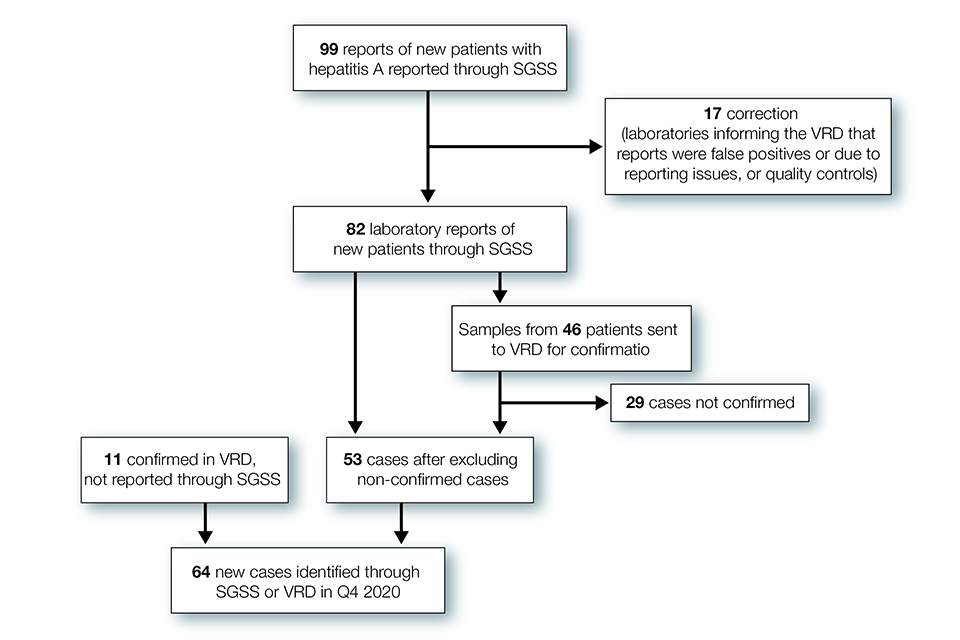Laboratory reports of hepatitis A infections in England and Wales: October to December 2020
Updated 10 May 2023
Applies to England and Wales
There were a total of 64 laboratory reports of new patients with hepatitis A reported during the fourth quarter of 2020 (October to December 2020) after exclusion of patients with samples sent to the Virus Reference Department (VRD) that were not confirmed as having had a recent hepatitis A virus (HAV) infection as well as inclusion of additional patients confirmed by the VRD (see table 1 and figure 1).
This was a 96.9% increase on the reports in the third quarter of 2020 (n=32); 82 patients were reported through the Second Generation Surveillance System (SGSS), after excluding corrections and before including the additional 11 confirmed cases identified by the VRD (figure 1).
Table 1. Laboratory reports of hepatitis in England and Wales, October to December 2020
| Age group | Females | Males | Unknown | Total |
|---|---|---|---|---|
| Less than 1 year | 0 | 0 | 0 | 0 |
| 1 to 4 years | 6 | 1 | 0 | 7 |
| 5 to 9 years | 3 | 3 | 0 | 6 |
| 10 to 14 years | 3 | 1 | 1 | 5 |
| 15 to 24 years | 2 | 4 | 0 | 6 |
| 25 to 34 years | 3 | 5 | 1 | 9 |
| 35 to 44 years | 2 | 3 | 1 | 6 |
| 45 to 54 years | 4 | 1 | 2 | 7 |
| 55 to 64 years | 3 | 4 | 1 | 8 |
| 65 years and over | 7 | 3 | 0 | 10 |
| Unknown | 0 | 0 | 0 | 0 |
| Total | 33 | 25 | 6 | 64 |
Notes: From Q1 2020, the central number of cases presented excludes false positives and includes additional cases identified by the VRD. Hence, numbers are not directly comparable to previous quarters. False positives are more likely in older age groups.
The South West UK Health Security Agency (UKHSA) region accounted for 25.0% (n=16) of reports, followed by 17.2% (n=11) from the London region. Age group and sex were well reported (table 1). There were 25 (39.1%) reports among those aged 45 years and over, followed by 21 (32.8%) reports among those in the 15 to 44 years age group and 18 (28.1%) in those aged under 15 years. Females accounted to 56.9% of reports (n=33), and males 43% (n=25).
The following flowchart shows there were 99 reports of new patients with hepatitis A reported through SGSS. There were 17 corrections (laboratories informing the VRD that reports were false positives or due to reporting issues, or quality controls), leaving 82 laboratory reports of new patients through SGSS. Samples from 46 patients were sent to VRD for confirmation and 29 cases were not confirmed. After excluding non-confirmed cases, 53 cases remained. Eleven cases were confirmed in VRD but not reported through SGSS, giving a total of 64 new cases identified through SGSS or VRD in Q4 2020.
Figure 1. Flowchart of laboratory reports of hepatitis A by age and confirmation status by the VRD (England and Wales), October to December 2020

Figure 2. Laboratory reports of hepatitis A by age and sex in England and Wales, January 2002 to December 2020

Notes: All figures are provisional and subject to change as records are updated. From Q1 2020, the central number of cases presented excludes false positives and includes additional cases identified by the VRD. Hence, numbers are not directly comparable to previous quarters. False positives are more likely in older age groups.
Reference laboratory confirmation and phylogeny of hepatitis A infections
Of the 53 patients notified as having acute HAV infection during the last quarter of 2020, 18 had samples forwarded to the VRD for genotyping. In addition, 11 patients were confirmed to have acute HAV infection that had not been reported through the laboratory reporting system although all the English cases were recorded in HPZone.
A total of 26 patient samples could be genotyped over this period: 8 were genotype IA (30.8%), 5 were genotype IB (19.2%) and 13 were genotype IIIA (50%).
The resulting data is presented below as a phylogenetic tree (figure 3) where each sequence is represented by a dot followed by the patient region, and the week of sampling in brackets. Of the genotyped samples, 15 were associated with travel (57.7%), 9 had no travel history (34.6%) and 2 had no information (7.7%).
Figure 3. Phylogenetic tree of genotype IA, IB, and IIIA sequences October to December 2020 (n=26)

